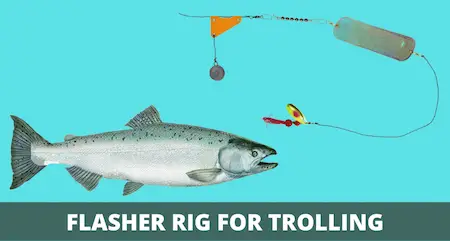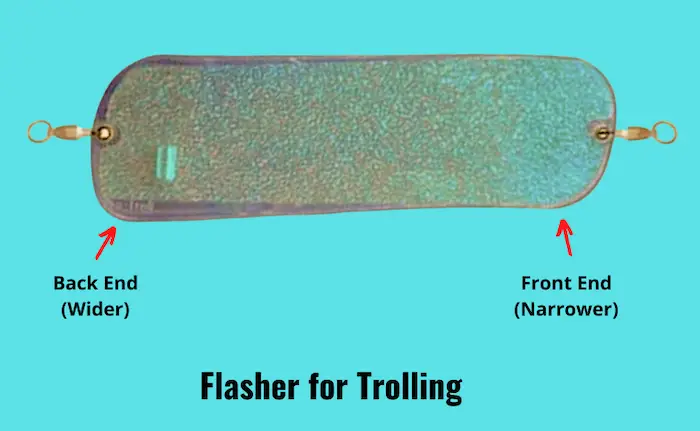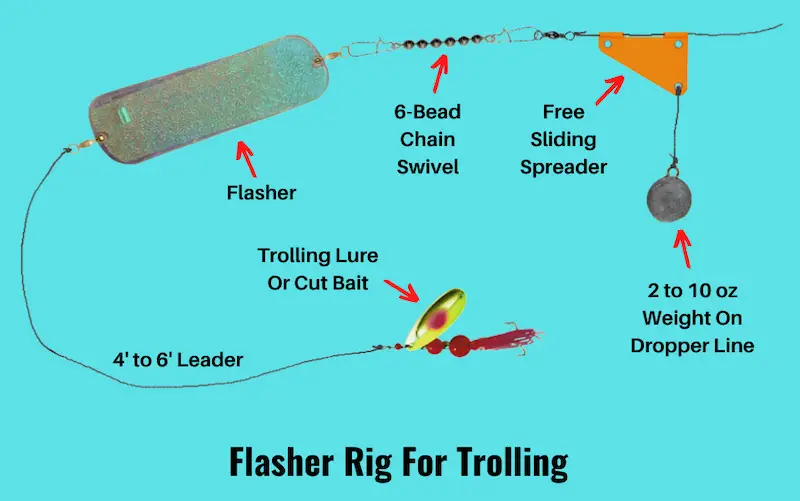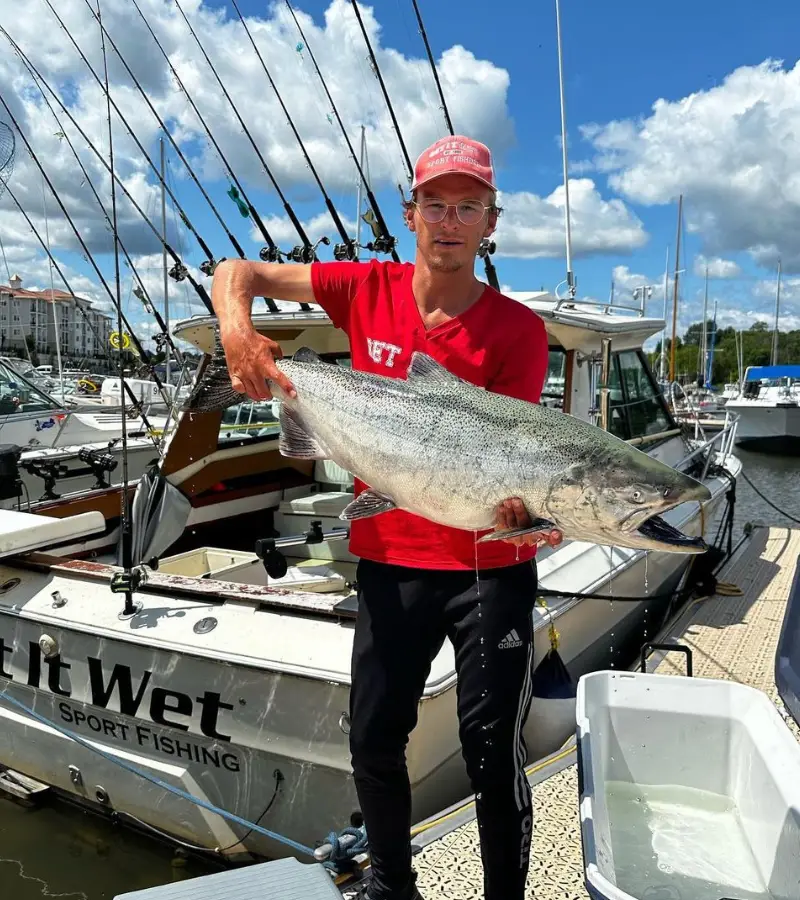Flasher Rig for Trolling (Setup & How-to Guide for Beginners)
PUBLISHED 26 JULY 2023
by Robert Ceran
Are you planning to use a flasher rig for trolling, but aren’t sure how to set it up, or how to fish it for optimal results?
While the flasher rig is without a doubt one of the most powerful salmon trolling rigs (and also catches large trout), it can be tricky to set up and to troll it at the right speed and depth.
In this article I’ll walk you through setting up the flasher rig, and will aso cover what lures and bait to use with it, and how to troll it to put more fish in the boat.

What is a flasher rig (and what is it good for)?
A flasher rig is an attractor setup used for salmon and trout trolling. A flasher consists of an 8 to 11 inch long rectangular piece of hard plastic that is attached to a fishing line with a swivel at each end.

A flasher is slightly narrower at the front end and curved both at the front and the back, and this design produces a spinning motion when it is pulled through the water.
Using a flasher for trolling provides two key benefits:
Firstly, the flasher is brightly colored, and the colors and vibrations it gives off due to its spinning motion serve to attract salmon, lake trout, and other fish from a long way away.
Secondly, the motion of the flasher also imparts action to the trolling lure or bait that is rigged behind it, and this helps to trigger bites when fish come closer to investigate the commotion caused by the flasher.
Overall, flasher rigs catch more salmon every year than any other fishing rig, and are thus well worth the effort of setting up.
Flasher rig components
You’ll need the following tackle components to set up a flasher rig:
- Flasher (or dodger)
- Sliding spreader
- 2 to 10 oz weight
- Barrel swivel
- 6-bead chain swivel
- 60 to 80 lb test braided main line
- 20 to 30 lb test monofilament dropper line
- 20 to 30 lb test fluorocarbon leader line
- Trolling lure or bait
Note that the dropper line and leader line are intended to be significantly weaker than your main line.
That way, if either your weight or lure gets snagged on the bottom, you’ll have the option to break them off without losing the rest of the flasher rig. And since flashers are expensive, you’ll want to make sure you don’t lose them every time you get snagged.
Also, the chain swivel helps to keep the spreader and sinker separate from the flasher, which helps to avoid tangles. Some anglers prefer to use rigging wire for this, and based on my testing either will do the trick.
How to set up a flasher rig

Start by threading the sliding spreader onto your main fishing line, followed by tying it to a barrel swivel. Next, attach an 8 to 12 inch dropper line to the spreader, and then tie a heavy 2 to 10 oz. sinker to the other end of the dropper line.
After that, attach one of the two snaps of a 6-bead swivel chain to the barrel swivel that you tied to the main line during the first step, and attach the second snap to the flasher.
Next, measure out 4 to 6 feet of leader line (I prefer to use fluorocarbon for this, due to its low visibility in the water), and tie it to the other end of the flasher. In the final step, tie a snap swivel to the other end of the leader, as this will allow you to swap out trolling lures easily.
What bait should you use with a flasher rig?
The beauty of a flasher rig for trolling is that it can be used with pretty much any trolling lure, including inline spinners, crankbaits, plugs, spoons, salmon hoochies or swimbaits.

Image source: instagram@jcgoulardfishing
You can also use it with natural bait by trolling a meat rig behind your flasher setup. A meat rig for salmon fishing is ideal for attaching a plug cut herring, or a whole dead herring so that it can be trolled with a flasher.
Using natural bait comes with the additional advantage of generating attractive scents and texture that trigger bites from salmon that are drawn in by the spinning action of the flasher.
How to fish a flasher rig
The easiest way to fish a flasher rig is to troll it without a downrigger, which allows you to target fish in relatively shallow water up to about 40 to 50 feet.
You can control the depth at which your flasher rig runs in the water by changing the size of the weight, and by changing your trolling speed.
But keep in mind that a flasher requires faster trolling speeds in order to spin properly in the water (and higher trolling speeds are better for salmon anyways). So if you want to troll more slowly, it’s better to switch to a dodger setup instead.
Trolling a flasher rig with a downrigger
While you can definitely troll a flasher rig without a downrigger, this will only allow you to reach a maximum depth of about 50 feet, even if you’re using a heavy 10 oz. sinker.
If you want to troll deeper than 50 feet, you’ll need to use a downrigger to get your flasher setup deep enough in the water. This is especially important for salmon trolling, since they often hold in deep waters.
A downrigger comes with a 10 lb lead ball, which is lowered with a heavy line that’s played out from the spool of the downrigger setup.
Attach your flasher rig to the downrigger weight with a special release clip, which allows you to release the line when a grabs the bait and you set the hook.
Keep in mind that when trolling your flasher setup with downriggers, you’ll need a heavy long fiberglass rod that will be able to handle the strain of the heavy downrigger weight.
Also, when trolling a flasher rig with a downrigger, you don’t need to use a weight on the flasher setup itself, since its depth is entirely dependent on the downrigger weight.
Flasher vs dodger – what’s the difference?
The main difference between flashers and dodgers is that flashers are built to spin in the water (ie. rotate on their long axis), while dodgers are built to wobble in the water. And while flashers and dodgers look superficially similar, they produce very distinct actions in the water.
Also, dodgers work better at slower trolling speeds, while flashers work better at higher speeds. Because of this, dodgers are most often used as rigs for trolling when targeting trout, while flashers are used more for salmon trolling.
